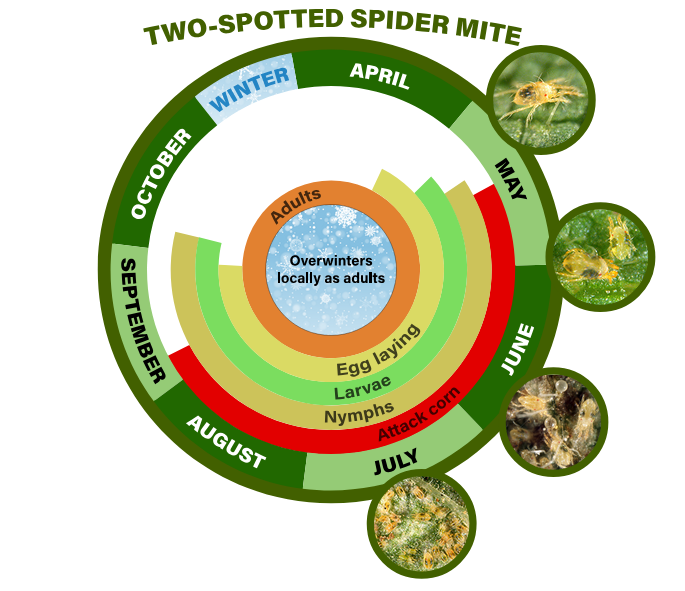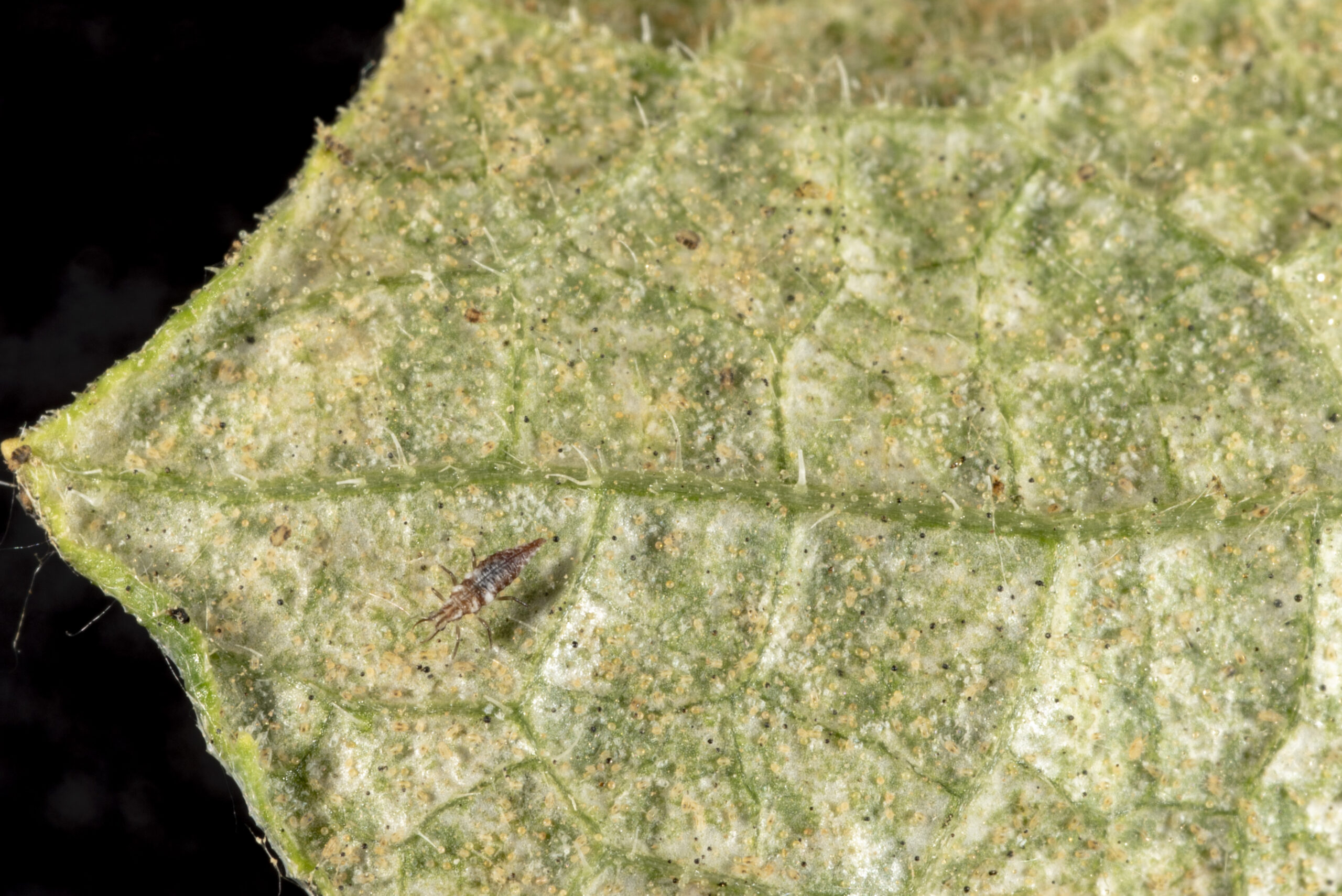Two-spotted Spider Mites (Corn)
Tetranychus urticae Koch
Search the Pest & Crop Newsletter

The ability to see these full-sized life-cycle images is currently disabled to resolve an issue.
Related Video Resources:
Appearance and Life History

Photo by J. Obermeyer
The two-spotted spider mite (TSM) is one of many phytophagous, or plant feeding species of mites. Mites are not insects, this is important to remember when selecting pesticides for control. Common hosts are clover, chickweed, and various roadside grasses. TSM population outbreaks may increase significantly if high temperatures are associated with prolonged dry conditions. Drought conditions often lead to mite outbreaks.
Egg – The spherical, shiny straw-colored eggs are very small. Webbing produced by the TSM, which helps fasten the eggs to the leaf surface, makes the eggs difficult to see.
Larva – The six-legged, colorless, larva resembles the body form of the nymph and adult. It is slightly larger than a TSM egg. During the larval stage, little food is consumed.
Nymph – The eight-legged nymph looks like an adult, but is smaller and not sexually mature. It goes through 2 nymphal stages, proto-nymph and deuto- nymph, before becoming an adult.
Adult – The adult female is eight-legged and about 1/60 inch (0.4 mm) long. The eight-legged male is only about 1/80 inch (0.3 mm) long. Their color varies from pale yellow to green to orange to brown.
The adult TSM overwinters in non-crop and weedy areas such as grassy waterways, roadsides, weeds, set-aside acres, and pastures. As temperatures warm in the spring, TSM begins feeding on their common hosts such as clover, chickweed, and various grasses. Mating and egg laying soon follow and continue throughout the mite’s lifespan. Under optimum conditions of high temperatures and low humidity, this mite can complete its development in 5 to 7 days. Under more typical temperatures and humidity, the generation interval is approximately 19 days.
Damage

Photo by J. Obermeyer
TSM feeds by piercing leaf cell walls with its mouthparts and sucking out the cell’s contents. These cells become irreversibly non-functional, no longer contributing to plant growth and development. However, depending on growth stage, corn may be able to produce new leaf growth if environmental conditions improve.
Symptoms may include leaf yellowing to brown leaves, mottled or “sand blasted” appearance, and a general decline in plant growth. Damage may be enhanced by poor growing conditions and/or soil compaction.
Sampling Method
- If hot, dry conditions persist for several weeks, watch for leaf discoloration (yellowing) especially along the field borders or near grassy areas within fields. Carefully inspect these areas for the presence of TSM.
- Shake discolored leaves over a white piece of paper. Watch for small dark specks moving about on the paper and look for minute webbing on the undersides of the discolored leaves.
- Once TSM has been positively identified in the damaged areas of the field, scout the whole field to determine the range of the infestation.
- Sample at least 5 different areas of the field and determine if TSM are present by shaking leaves over a piece of paper.
- If plant discoloration is noted, estimate the average percentage leaf discoloration for the plants within the damaged area.
- Repeat this procedure in other areas showing damage.
Management Guidelines
Corn Insect Control Recommendations:
- Control may be necessary when 15% to 20% of the leaf area is covered with TSM colonies, moderate damage is noted, and hot, dry conditions are expected to continue.
- Greatest benefit from control normally occurs when miticides are applied from the pre-tassel through the soft dough stages of plant development.
- Because mites colonize on the underside of leaves, thorough coverage of corn leaves with a miticide is necessary for TSM control.


Photo by J. Obermeyer
Though rarely seen because of their size, spider mites have numerous predators and pathogens that attack them. During good crop growing conditions, unless broad-spectrum insecticides are used, many species of beneficial insects (including predaceous mites) feed on spider mites attempting to colonize plants. During periods of high humidity, fungal pathogens spread through the spider mite population keeping them in check.
